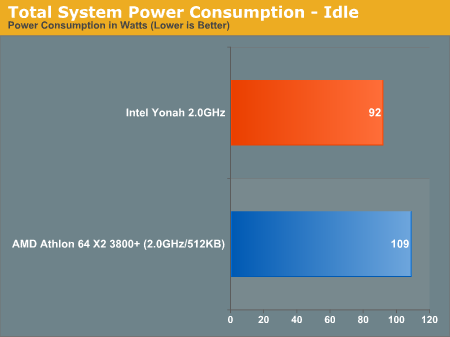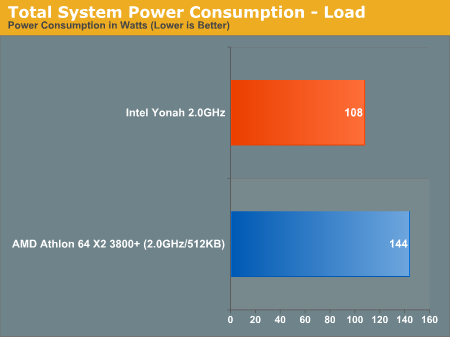Intel Yonah Performance Preview - Part I: The Exclusive First Look at Yonah
by Anand Lal Shimpi on November 30, 2005 2:50 AM EST- Posted in
- CPUs
Power Consumption and Final Words
At 2.0GHz, Yonah is basically equal to, if not slightly slower than an Athlon 64 X2 running at the same clock speed in virtually all of the tests we ran. The important distinction here is that Intel is able to achieve that level of performance, without an on-die memory controller. But there is also one more thing to note, Yonah can offer that level of performance with significantly lower power consumption:


While the Yonah and Athlon 64 X2 systems consumed relatively similar power at idle, Yonah hardly eats up any more power under full load. In fact, a 2.0GHz Yonah under 100% load consumes less power than an Athlon 64 X2 3800+ at idle. Obviously Intel has the advantage of being on a much lower power 65nm process, but it won't be until the second half of next year before we see any Athlon 64 X2s at 65nm, so it is an advantage that Intel will have for quite some time.
Although we didn't consider it as such here today , Yonah will be quite impressive on notebooks. The thought of having such a cool running dual core processor in a notebook is honestly amazing, and the performance difference (especially for multitaskers) over what we have today will be significant. The other thing to keep in mind is that when you go from a single core to a dual core Pentium M notebook, you won't be giving up anything at all. On the desktop side, you normally give up clock speed for dual core support, but Yonah will be running at very similar frequencies to what Dothan is running at today. In other words, you won't be giving up single threaded performance in favor of multi-threaded performance - you'll get the whole package.
As a desktop contender, Yonah is a bit of a mixed bag. While its performance in content creation applications has definitely improved over the single core Dothan, it still falls behind the Athlon 64 X2 in a handful of areas. Intel still needs to improve their video encoding and gaming performance, but it looks like we may have to wait for Conroe and Merom for that.










135 Comments
View All Comments
JoKeRr - Friday, December 9, 2005 - link
http://www.notebookforums.com/showthread.php?p=147...">http://www.notebookforums.com/showthread.php?p=147...a new model of toshiba with yonah @ 2ghz, 2x512ddr2 667 annd x1400 graphics. Very interesting.
Obviously yonah with 2x512mb ddr2 667 should perform better overall than ddr2 533.
Similar to how dothan with ddr2 533 completely smokes out dothan at same speed but ddr2-400 or ddr333 (and surprisingly many manufacturers adopted that, example: sony FS toshiba m50 etc... stupid choice for the manufactures, not to mention turbocache or hypermemory will suffer a lot as well due to slower access to system memory).
So when is the official release date for Yonah based lappy?? and where's the Part II of Yonah article??
Thanks again AT, great job.
IntelUser2000 - Monday, December 12, 2005 - link
It was weird how single channel DDR2-533 is faster than dual channel DDR2-400 for Dothan. It seems the chipset doesn't take advantage of dual channel at all, so getting faster single channel stick is better than slower dual channel. So I assume it will be same for Yonah.
Yonah will be released Jan 5, 2006 at CES(some trade show I heard).
Furen - Thursday, December 15, 2005 - link
Two DDR channels are bottlenecked by the FSB. The P4 can use dual-channel DDR effectively because of its much higher FSB.cryptonomicon - Saturday, December 3, 2005 - link
I think yonah is a nice option for low power compact notebooks. As we can see here it doesnt really compare against the desktop amd X2 parts, but will line up good against mobile duel semprons and turion right? Also to be noted is that it has a low clock speed. How will it overclock?.. this interests me greatly.IntelUser2000 - Monday, December 5, 2005 - link
Actually the highest end will initially be available at 2.17GHz, and a quarter later there will be 2.33GHz. There will be "Extreme Edition" like versions that are clocked 1 or 2 speed grades beyond the 2.33GHz, so 2.5 or 2.67GHz. Of course the "EE" versions will be higher power consumption(Actually its officially called E).
snorre - Saturday, December 3, 2005 - link
Are you trying to make "Yonah" look better than it really is (another Intel lemon) perhaps?And did you check for CPU throttling activity in your power consumption tests?
Zebo - Friday, December 2, 2005 - link
Everyone keeps talking about power consumption..I for one am not impressed. First of all with AMD - X2 in these tests is basically a overvolted part.. will run just fine at 2.0Ghz with 1.15-1.2V rather than 1.4V used here, lowering power signifigantly in "X2 turion" form when it gets here. Second, even so, the power consumption difference was'nt that great 109W vs 144W loaded.. It's not like comparing a P4 setup which sucks over 300W or double X2 power just to run here - you're talking 30-40W differential which will surley be addressed with the addition of DDR2 and unvervolting even AMD's 90nm processes. Nevermind what 65nm should add. AMD's not in trouble in this sector and Yonah gods greatest gift to the sector either. Since we can't buy product now it all moot anyway but either should make a great notebook.Since I don't like notebooks I wish anand had done some serious clocking here - after all I/we really care about is can intel reach 3.0+ Ghz with this process and Yonah for those of us who want to slam these chips on the desktop and as a precusor to Conroe.:) That's what intel really needs to perk my intrest again. 3+ Ghz to really compete again on desktop - I don't really see them getting back to Northwood vs Athlon XP day with this chip though no matter how high it clocks.
Marmion - Thursday, December 8, 2005 - link
Ever thought that speedstep wasn't used when compiling this test. Also we're basing consumption on the entire platform. This platform would differ compared to the Centrino platform - low power graphics, wireless and chipset. When idle, the Yonah core shuts down a core. It is fairly obvious that the consumption figure shown for the Yonah does not utilise speedstep. You can also underclock a Dothan if you want.I also find it difficult that the Turion X2 being cheaper than an equivelent Yonah, as shown by the price difference with AMD64 X2 over the single core equivelent, however the Yonah cost is equal to the Dothan at the next highest frequency, but the yonah has 2 cores - ie Yonah @ 2Ghz = Dothan @ 2.13Ghz.
A Turion X2 will give up performance of the desktop equivelent to save power - its to be on the 90nm platform. So Yonah compared to a Turion X2 looks very good in all rspects (except 64bit but I don't need it so I don't care)
IntelUser2000 - Monday, December 5, 2005 - link
Who cares if X2 can be undervolted or overvolted?? Its not. That's default voltage of X2's. By under or overvolting it you are essentially putting it out of spec. Probably Yonah can be undervolted too. Whats your point here??? Plus DDR2 does not consume that much less power, since DDR2 clocks higher. I have even seen presentations that say 533MHz DDR2=400MHz DDR. Though its likely that's wrong, it shows that DDR2 isn't low power as you think.
For those who thinks dual core Turions with DDR2 would make it lower power. No, because the DDR2 would be at 667MHz, NOT consuming less than DDR400, plus it will be dual channel, unlike the single channel on the current Turions, ACTUALLY consuming MORE power.
People are essentially dumb here since most people almost assumes Yonah is a desktop chip. And people whos saying Yonah MAY be competitive at 2.6GHz, there WILL be 2.5-2.67GHz versions on "Extreme" ones. That's gonna be something as it would be higher clocked than X2's.
DDR2 DOES NOT have power consumption advantage since it CLOCKS MUCH HIGHER THAN DDR. The tested configuration DOES NOT use a mobile chipset.
AMD has NO PROCESS advantage by using SOI, since at 90nm and 65nm process, Intel is superior in leakage current at SAME transistor speeds for BOTH process WITHOUT using the wonderful SOI some are touting.
65nm DOES NOT NECESSARILY LOWER POWER OVER 90nm, look at initial AXP's at 130nm, called Throughbred, they were about 10% less power and no overclock.
Zebo - Wednesday, December 7, 2005 - link
Claim down fanboy.. geez even your user name says it you don't have to keep broadcasting it. It's default for a desktop chip, it's overvolted in the sense that anands substituting a desktop chip and competing with a notebook product here...as in the dual turons slated for lappys will be 1.2 or 1.25, not 1.4 futher reducing power..just like turions today vs regualar desktop A64's. If you really think Dual turions will be 1.4 then we have nothing further to discuss.And you're just wrong about DDR vs DDR2
http://www.samsung.com/Products/Semiconductor/DRAM...">http://www.samsung.com/Products/Semicon...Info/101...